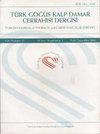Short-term results of chimney stent revascularization of left subclavian artery and Zone 2 thoracic endovascular aortic repair for patients with aortic dissection or transection
IF 0.5
4区 医学
Q4 SURGERY
Turk Gogus Kalp Damar Cerrahisi Dergisi-Turkish Journal of Thoracic and Cardiovascular Surgery
Pub Date : 2022-01-01
DOI:10.5606/tgkdc.dergisi.2022.22541
引用次数: 0
Abstract
Background In this study, we present the short-term results of revascularization of left subclavian artery with the chimney technique in patients with aortic dissection or transection who underwent Zone 2 thoracic endovascular aortic repair. Methods A total of 11 patients (6 males, 5 females; mean age: 56.4±11.5 years; range, 38 to 76 years) who underwent Zone 2 thoracic endovascular aortic repair procedure and left subclavian artery revascularization with the chimney technique between April 2017 and January 2020 in our clinic were retrospectively analyzed. All patients were followed at one, three, six months and one year with computed tomography angiography. Results The mean follow-up was 19.7±14.5 (range, 6.3 to 45.8) months. Endoleak occurred in one (9%) patient and gutter leak occurred in three (27%) patients. The mean endoleak-free (including gutter leak) time was 19.9±5.4 (95% confidence interval: 9.36-30.34) months. No mortality occurred in any of the patients. No occlusion occurred in the chimney grafts. Conclusion The chimney revascularization technique is an alternative to other revascularization techniques of the left subclavian artery during thoracic endovascular aortic repair.烟囱支架左锁骨下动脉血运重建及胸2区血管内主动脉修复治疗主动脉夹层或横断的近期效果
在本研究中,我们报告了用烟囱技术重建左锁骨下动脉的短期结果,这些患者因主动脉夹层或横断而行胸腔2区血管内主动脉修复术。方法11例患者(男6例,女5例;平均年龄:56.4±11.5岁;回顾性分析2017年4月至2020年1月期间在我们诊所接受2区胸腔血管内主动脉修复术和左侧锁骨下动脉血管重建术的患者,年龄38至76岁。所有患者分别在1个月、3个月、6个月和1年接受计算机断层血管造影。结果平均随访时间为19.7±14.5(6.3 ~ 45.8)个月。1例(9%)患者发生内漏,3例(27%)患者发生沟漏。平均无内漏(包括地沟漏)时间为19.9±5.4(95%可信区间:9.36-30.34)个月。所有患者均无死亡。烟囱移植物未发生闭塞。结论在胸椎血管内主动脉修复术中,烟囱血管重建术可替代其他左锁骨下动脉血管重建术。
本文章由计算机程序翻译,如有差异,请以英文原文为准。
求助全文
约1分钟内获得全文
求助全文
来源期刊

CiteScore
1.00
自引率
0.00%
发文量
98
审稿时长
3-8 weeks
期刊介绍:
The Turkish Journal of Thoracic and Cardiovascular Surgery is an international open access journal which publishes original articles on topics in generality of Cardiac, Thoracic, Arterial, Venous, Lymphatic Disorders and their managements. These encompass all relevant clinical, surgical and experimental studies, editorials, current and collective reviews, technical know-how papers, case reports, interesting images, How to Do It papers, correspondences, and commentaries.
 求助内容:
求助内容: 应助结果提醒方式:
应助结果提醒方式:


